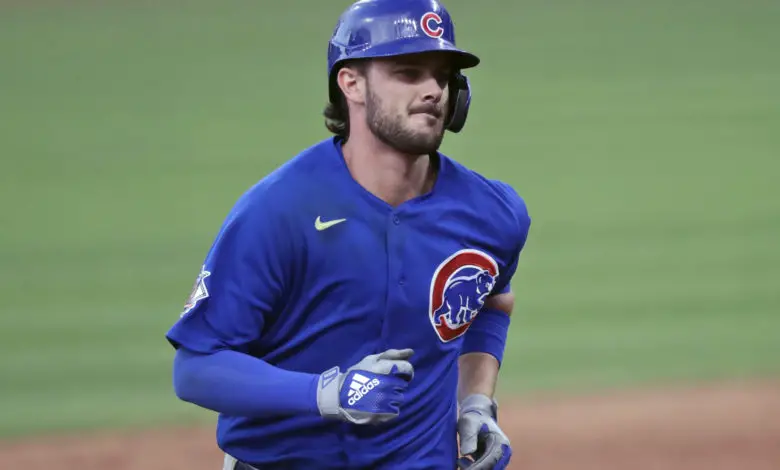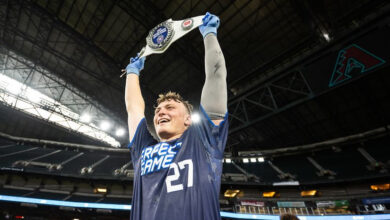
Kris Bryant Played Most of 2020 Season with Fractured Left Wrist, Torn Ligaments in Ring Finger
After getting off to a slow start, Kris Bryant‘s 2020 season was more or less doomed on August 12 when he launched a big home run in the top of the 6th in a win over Cleveland. Initially viewed as a sign that his awkward landing on a diving attempt in left field the previous inning wasn’t as bad as it looked, the injuries he suffered were actually far worse than he or the Cubs let on.
As Cubs Insider learned a few days after the incident — and a few days prior to being placed on the IL — Bryant had suffered an impact fracture in his left wrist and two torn ligaments in his left ring finger. The latter is a sprain, which was reported, it’s just more on the severe side than merely stretching things a little too much.
Of course, we had to couch the knowledge of the severity as hypothesis (see Ed. note in link) because Bryant himself had not disclosed it. That changed Tuesday during a conversation with NBC Sports Chicago’s Gordon Wittenmyer during which Bryant revealed the fracture and his reasons for keeping it under wraps.
“I’ve played through a lot of things that were bothering me because I wanted to play, I want to be on the field, I want to help the team, I want to compete. Good or bad,” he explained. “I could have spoken up a little more and said hey I’m not feeling really good. Maybe if I did that I might have set myself up better down the road.
Bryant also addressed the foolish criticism for his honest response to a question about his joy for the game, saying he isn’t going to stop being genuine and answering questions honestly. It’s strange that media and fans alike will rip one guy for giving rote responses, then they’ll turn around and do the same to someone who’s transparently himself.
Well, except when it comes to that wrist injury. But what choice did Bryant have when disclosing it would only have led to accusations that he was making excuses for his poor performance? Hell, we get all kinds of crap here at the site for pointing out the very obvious facts about how shoulder and knee injuries have impacted his performance in the past.
This is the point where I will say yet again that being hit in the head by a German Marquez pitch in 2018 had absolutely nothing to do with any performance issues. Nor is it a matter of Bryant failing to adjust his swing or plate approach. I’ve led too many horses to water only to watch them die of thirst to believe I can change minds at this point, but I’ve included some additional information below the break just in case your mouth is feeling dry.
Now, you may be wondering why Bryant was even playing at all if he and the Cubs understood the true nature of his injury. Setting aside the irony of Bryant replacing Mike Olt a fractured wrist — and, more importantly, the service-time clock — dictated a move, it still seems a little reckless on the surface. Further setting aside the Cubs’ highly questionable non-use of the IL many times over in the past, this was one of those issues that almost certainly wasn’t going to get worse by playing.
At the same time, Bryant’s performance wasn’t going to get better by playing because it’s damn near impossible to generate the bat speed required to catch up to high heat with a jacked-up wrist. That contributed to his erratic performance in September and also helps to explain his strong finish after sitting for a few days with an oblique issue.
The formula was simple: Rest the wrist, get treatment, stop giving a shit, rock two chains, hit dingers. Now it’s a matter of getting everything right from a timing perspective and, ideally, remaining as healthy as possible throughout 2021. Because when healthy, Bryant is unquestionably the Cubs’ best hitter.
Ed. note: What follows are some statistics to debunk the beanball theory and the notion that Bryant hasn’t made significant adjustments. The reason both concepts have persisted is that people can’t or won’t properly contextualize performance. Rather than simply looking at a stat line and drawing conclusions, we can sort by dates and view samples in before-and-after blocks.
As a quick aside before I get to that, though, I do want to quickly revisit the note above about having this information about seven months ahead of it coming out. That’s not the easiest thing in the world to just sit on, especially for a blog that has neither the platform nor the protection of much larger outlets.
Overall stats
Bryant wore that Marquez pitch on April 22, then sat for a few games before returning on April 28 and going hitless with two strikeouts over his next eight plate appearances. Overall, though, his offensive production was almost identical in his first 95 plate appearances following the beanball (.293/.389/.622, .422 wOBA, 168 wRC+) to what it had been in 89 PAs prior (.319/.461/.536, .423 wOBA, 169 wRC+) Then came the fateful headfirst slide against the Reds on May 19 that jammed his left shoulder and effectively ruined his season.
Prior to the shoulder injury, KB was at .305/.427/.583 with a .424 wOBA and 169 wRC+ in 185 plate appearances. Those numbers were all well above his MVP stats, in case you were wondering. He then posted a .252/.338/.382 slash with a .315 wOBA and 96 wRC+ over his next 272 PAs.
His knee injury in 2019 was a little more stealthy. Bryant entered the All-Star festivities batting .297 with a .955 OPS and 148 wRC+, all better marks than he’d posted in his 2016 MVP campaign. Then he tweaked his knee when his cleat caught in a turf mat during BP and the discomfort persisted throughout the second half. He still managed to hit .261 with an .829 OPS and 116 wRC+ in the second half, but his exit velocity dropped by 3 mph and he wasn’t as explosive.
Adjustments
We’ve covered this particular topic exhaustively over the years, so search “Bryant adjustments” or something similar if you really want to make a deep dive. He had a steeper swing plane as a rookie, but very clearly adjusted it heading into his second year; we’ve actually covered this in great detail. His strikeout numbers dropped dramatically over the next two seasons and remained within 1-2% of league average (including two seasons below) from 2016-19.
The 2020 season saw him go back up as a result of the wrist injury. The shoulder and knee injuries significantly hampered very obvious progress as well. Prior to the shoulder injury in 2018, his K-rate was just 15.5% against a league average of 22.3% that year. It was only 19.5% in the first half of 2019 before he hurt his knee; league average was 23.0% that season.

